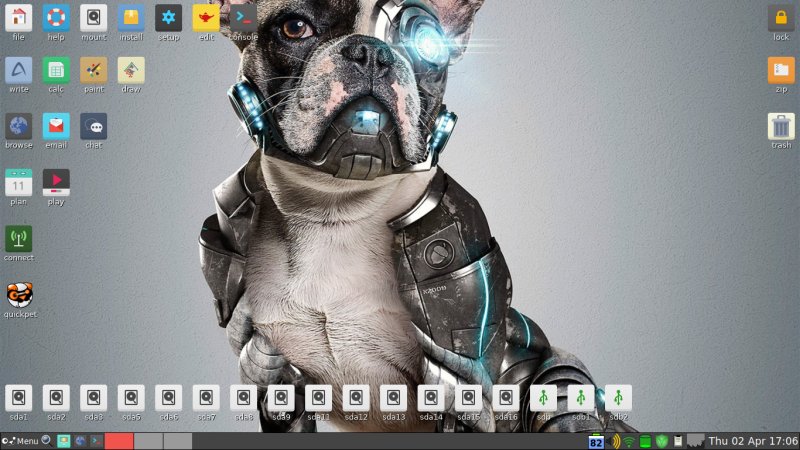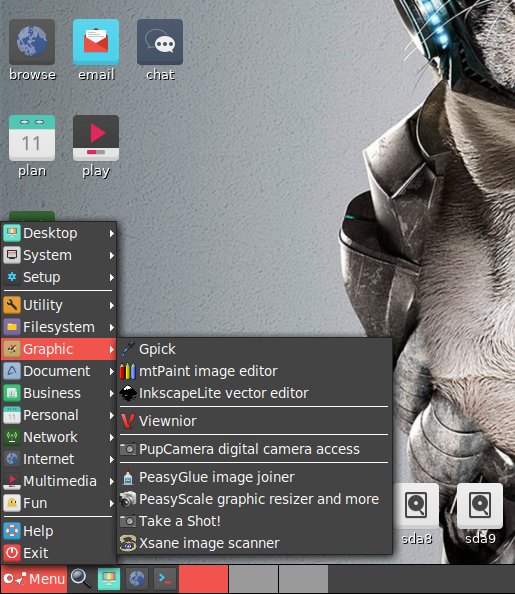Updated: April 13, 2020
In this day and age, one might feel like there's no need for distros like Puppy Linux. You could say, Ubuntu-based, why bother, use the official distro and whatnot. But that feeling and that saying would be misplaced. Because there's still room for ultra-frugal live-session Tux o' All Trades systems like Puppy. This is why we're here.
I've used Puppy for many a summer, and I've always liked its premise. Small, fast, live CD/thumb drive system with optional persistence, lots of apps designed to work out of the box on all manner of hardware, including old and weak systems. In a way, this is your Swiss Army knife for travel and opportunistic use. But going back to the skeptics, is it still relevant in 2020? Let's find out.
Revving up
No problem getting the distro booted on my UEFI-powered Lenovo G50 machine. A good start. Then, Puppy also comes in 32-bit flavor for those using ancient hardware (like me eeePC, for instance), and there's also an edition for Raspberry Pi. Sweet.
Moreover, Puppy has improved in how quickly it gives the user a workable session. In the past, it would ask a lot of boot questions (like keyboard, timezone and video setup), but now, all of it is condensed into a single Quick Setup wizard. Happy? Just close it, and start using Puppy.

The wallpaper is dope - we have Locutus of Pup there, nice icons. Here and there, Puppy feels outdated or perhaps purposefully old, but it's still a fully functional desktop, with lots of goodies designed to give you connectivity, productivity and fun out of the box, with a tiny, fast footprint.

Wizards, wizards everywhere
I went about doing my routine testing session. For everything you do, I do it for ... there's a guided wizard. Sometimes too verbose, sometimes with too many steps ... but ... in the end, I was able to accomplish all of the desired tasks, without errors. For example, Wireless connectivity, good. Samba sharing, no problem! There's a tool that will probe hosts (servers), and return the list of available shares, and then let you mount and bookmark them for future use.



I was then able to copy music and video over, and play them without any issues. I was able to save files locally and onto the network, mount the internal volumes (including NTFS), and then some. It wasn't as pretty as it could be, but it was absolutely, fully functional, and for this kind of distro, and this kind of use, this is more than acceptable.
Applications
Lots of it. You might not necessarily be familiar with all of the available tools, but they work. The 2003 look will probably deter some, but remember, there are many pretty but useless distros out there. Puppy goes for the opposite approach (and it ain't really ugly, just not super posh as you might expect).



However, it's not all arcane. You have Pale Moon for browser, mpv for videos and music, DeaDBeeF for music again. There's AbiWord, InkscapeLite, Grsync, password manager, encryption tools, an endless collection of utilities, and then some. The magic of Puppy is that it manages to cram all these into a 350MB image.





Resources
BionicPup 8.0 was fast. Really fast. Well, with everything loaded into memory and no real need for disk access, this is kind of expected. So you also enjoy a quick session. Looking at the task manager, the distro was using about 450 MB of RAM, and the CPU ticked about 1%. Pretty neat, and I'm sure the footprint can be much smaller on older machines with less memory. In fact, I will most likely test this on my netbook.

Other stuff
I also noticed BionicPup comes with a tremendously rich context menu. Just right-click on a file, and you'll see an endless list of options. Perhaps too many. But you can do a lot of things. On top of that, it was stable, there were no errors or issues of any kind, and I was enjoying a rather pleasant retro-modern session.

Then, come the end of the session - another wizard. This one asked me if I wanted to save my session. I committed the work to an internal partition (/dev/sda13 if you care), so whenever I want to pick up my work, there it is, waiting.
Conclusion
Puppy Linux delivered on its happy message, and even exceeded my expectations. Now, I've always been a fan, and rarely had anything bad to say, so a positive result was kind of warranted. What really amazed me was not that this is a lean and fast little distro - it's the fact it manages to keep its relevance despite the obvious lethargy in the Linux desktop space. You may say, well, why bother - but if you have older hardware or travel a lot, Puppy gives you your own, complete work session that will boot and run pretty much anywhere, with tons of goodies and excellent configuration tools.
BionicPup 8.0 is a solid continuation of a strong line of tiny, frugal releases of the Puppy family. It's prettier than before (if still rather simple), it's fast and stable, it comes with all the amenities and nutrients a grown nerd needs, and it works really well. More testing to come for sure, but for now, I strongly recommend you grab yourself this phenomenal little distro, and go about exploring.
Cheers.